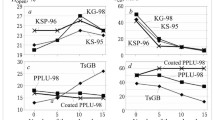Abstract
Destructive processes in refractory materials associated with thermal cycling (sharp heating and cooling) are discussed. A method for evaluating the thermal resistance of unshaped refractory materials is proposed that is based on the determination of a structure variation factor; a criterial formula for quantitative evaluation of the thermal stability of refractory materials at different thermocycling temperatures is derived.
Similar content being viewed by others
REFERENCES
S. K. Niyogi and A. C. Das, “Prediction of thermal shock behavior of castable refractories by sonic measurements,” Interceram., 43(6), 453 - 457 (1994).
T. Darroudi, J. Homeny, and R. C. Brandt, “Thermal shock damage resistance parameters of refractory castables,” Industrial Heating, May, 22 - 27 (1980).
Brian Cotterel, Sze Woo Ong, and Caidoug Qin, “Thermal shock and size effects in castable refractories,” J. Am. Ceram. Soc., 78(8), 2056 - 2064 (1995).
J. Szerba and J. Czechovski, “A comparative analysis of methods used to study the thermal shock resistance in refractory materials” [in Polish], Materialy Ogniotrwale (Refractory Materials), No. 3, 91 - 97 (1997).
K. K. Strelov and G. A. Gogotsi, “Current theories of thermal stability and prospects of development,” Ogneupory, No. 9, 39 - 47 (1974).
Author information
Authors and Affiliations
Rights and permissions
About this article
Cite this article
Goberis, S. Thermal Stability of Unshaped Refractory Materials. Refractories and Industrial Ceramics 44, 427–430 (2003). https://doi.org/10.1023/B:REFR.0000016783.12573.36
Issue Date:
DOI: https://doi.org/10.1023/B:REFR.0000016783.12573.36




